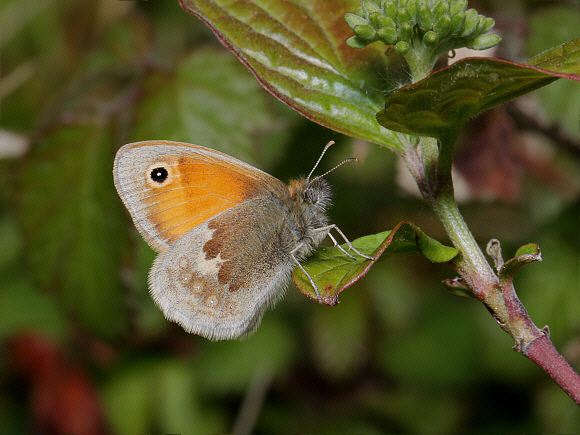 Small Heath Coenonympha pamphilus, Heyshott Down, Sussex – Adrian Hoskins
Small Heath Coenonympha pamphilus, Heyshott Down, Sussex – Adrian Hoskins
Introduction
This is one of the most widely distributed species in the Palaearctic region, being found throughout most of Europe, including most of the Scottish islands, most of the Mediterranean islands, and east across temperate Asia to Mongolia. It is also widespread across most of north-west Africa.
Prior to the 18th century the male Small Heath was called the Selvedged Heath Eye, and the female was known as the Golden Heath Eye. These names refer to the small but prominent ocellus at the apex of the forewing. Later it was realised that both “Heath Eyes” were the same species, which became known as the Gatekeeper, although that name is now associated with a different species – Pyronia tithonus. The name Small Heath was proposed by the famous 18th century entomologist Moses Harris, in his book “The Aurelian”.
In continental Europe there are several other similar Coenonympha species, but all of these have prominent ocelli on the underside hindwings. In Britain the only species with which pamphilus can be confused is the Scottish race of the Large Heath C. tullia, which has almost identical markings, but is much larger in size.
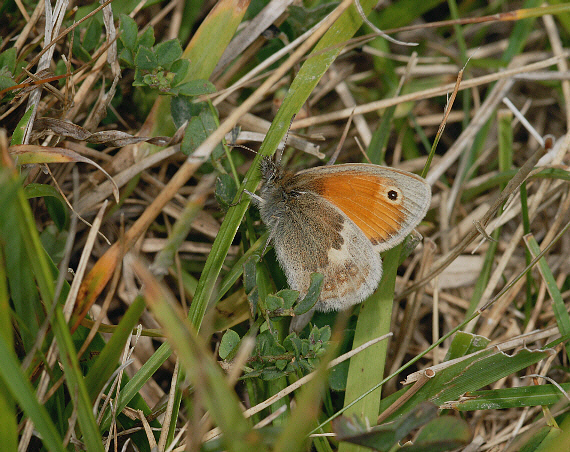 Coenonympha pamphilus in typical resting / basking posture amongst grasses – Adrian Hoskins
Coenonympha pamphilus in typical resting / basking posture amongst grasses – Adrian Hoskins
Habitats
Despite it’s common name, this is not primarily a heathland species, although populations do occur on the heaths of the New Forest and elsewhere. It is in fact found across a wider range of habitats than any other British butterfly – occuring on open grassland, mountainsides, road embankments, old quarries, cliff tops, sand dunes, heaths, moorlands, meadows and around field margins. It also occurs sparingly in woodland where it can be found in clearings and along wide grassy avenues.
It is most abundant at warm, well-drained, south-facing sites which are lightly grazed to produce a sparse sward of fine grasses. At such sites populations can sometimes be enormous, although they fluctuate dramatically in response to grazing and climate.
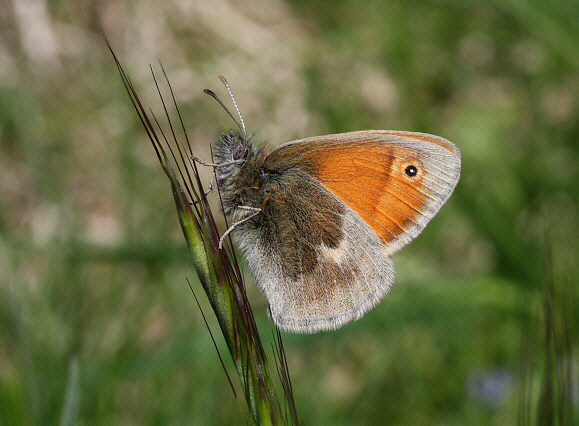 Small Heath Coenonympha pamphilus Cerne Abbas, Dorset – Adrian Hoskins
Small Heath Coenonympha pamphilus Cerne Abbas, Dorset – Adrian Hoskins
Lifecycle
In most areas of Britain the butterfly produces 2 broods, the first of which emerges as early as late April at the warmest sites, but usually in mid May elsewhere. Most areas produce a 2nd generation emerging in August and September, but in mountainous regions and in the far north there may be only a single generation, emerging in June.
Emergence times vary considerably from site to site. Thus it is possible to see the Small Heath on the wing at almost any time between April and October by visiting appropriate sites.
The eggs are spherical and can be either pale green or straw coloured, with reddish blotches. They are laid singly at the base of grass blades. The larva has several colour forms, varying from pale green to reddish-brown, but always with narrow white stripes, and tiny, twin pink and white prongs at the tail end. It feeds openly in daylight on tufts of Festuca, Agrostis and other fine grasses.
Some of the first brood larvae feed up quickly to produce adults in August, but others feed more slowly, with larvae of both broods entering hibernation in late September, some being quite small, while others may be half grown or almost fully developed. They over-winter at the base of the grasses, and resume feeding in late March.
The pretty pupa hangs by the cremaster from grass stems, and is pale green, marked on the wing cases with black stripes.
Adult behaviour
In the spring the butterflies nectar mainly at daisies, but the summer generation insects visit a much wider range of flowers including small scabious, marjoram, clover, thyme and heathers. Both broods however only visit low growing flowers, and rarely if ever nectar at taller plants such as knapweeds, hemp agrimony or thistles.
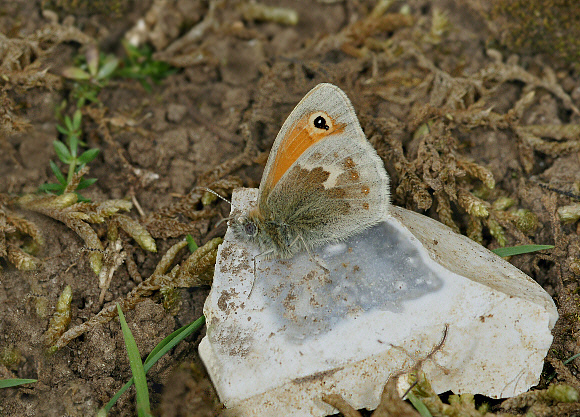 Small Heath Coenonympha pamphilus Stockbridge Down, Hampshire – Adrian Hoskins
Small Heath Coenonympha pamphilus Stockbridge Down, Hampshire – Adrian Hoskins
Small Heaths often settle on stones. The heat reflected back helps the butterfly to maintain a high body temperature and high energy levels needed for instant flight.
Males fly rapidly, zig-zagging or flying in tight circles just above the grasses, but rarely cover any distance. They frequently settle amongst grasses or on bare ground, and are attracted to small whitish objects such as stones, lumps of chalk, or bits of dry wood. Second brood males often settle on the pale flower-heads of stemless thistle or stemless carline thistle.
When the butterfly first settles it exposes the ocellus on the forewing apex for a moment, so that any bird which has spotted it will aim it’s beak at the false “eye” target. After a few seconds when the butterfly feels safe it tucks the ocellus out of sight behind the hindwings.
The butterflies spend long periods lateral-basking ( basking with wings closed ). By angling their wings to present the maximum wing surface to the sun they can absorb enough solar energy to keep their body temperatures high. Consequently they always have enough energy to instantly dart up and intercept passing females, or to escape from approaching predators. If on the other hand temperatures are high and the butterflies need to reduce their body temperature, they tilt towards the sun so that only the edges of the wings receive direct sunlight.
Males are mildly territorial – encounters with their own sex result in aerial sorties in which the pair spiral upwards flying in tight circles. When they reach a vertical threshold of about 3 metres above the ground, they split up and each male returns to ground level, although not usually to its original perch. With most territorial species, it is usual for the intruding male to be the loser in these battles, conceding defeat to the original “owner” of the territory. In the case of the Small Heath however the larger of the 2 males generally drives off the smaller, irrespective of which was the intruder.
Females fly to the male territories, flying about to attract the attention of potential mates. Courtship is very brief – the female settles on the ground, and the male nudges her with his head and then crawls alongside her, curving his abdomen to make contact. Mated pairs can often be found amongst grasses in late morning. If disturbed the pair will take flight, the female carrying the smaller male to a bush or another clump of grass. Copulation lasts about an hour.
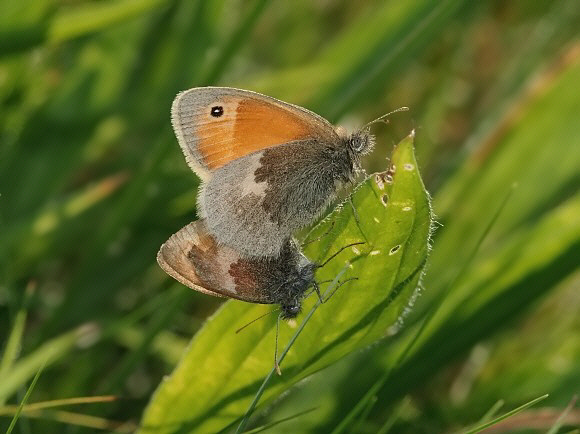 Coenonympha pamphilus, copulated pair, Cissbury Ring, West Sussex – Adrian Hoskins
Coenonympha pamphilus, copulated pair, Cissbury Ring, West Sussex – Adrian Hoskins
After separating the females disperse over open grassland to lay their eggs, spending what’s left of their lives walking or fluttering about amongst the grasses inconspicuously.
As dusk approaches the butterflies migrate across their sites to areas where there are long grasses and shelter from the wind. There they go to roost for the night, sometimes facing head-downwards, typically on grass-heads, plantain flowers or dead flowerheads of marjoram.
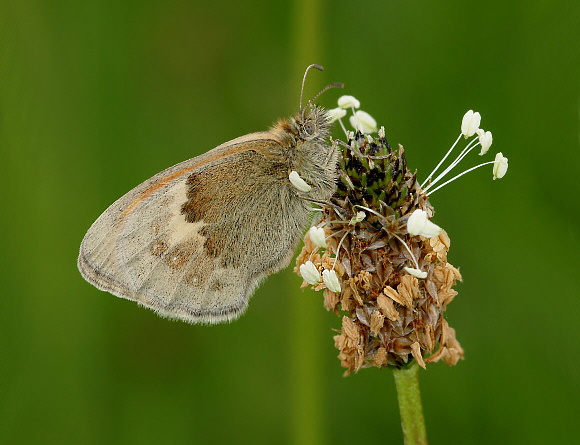 Small Heath Coenonympha pamphilus, female at roost on plantain flower – Adrian Hoskins
Small Heath Coenonympha pamphilus, female at roost on plantain flower – Adrian Hoskins
